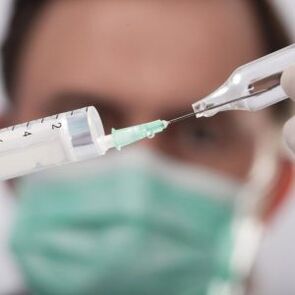
Papilloma virus treatment is a complex technique with surgical and therapeutic methods to eliminate the symptoms of the infection, its causes. Benign neoplasms - papillomas - can occur on different parts of the body or on mucous membranes. Most often, such formations are harmless, but there are situations when their removal is necessary to prevent the degeneration of the formation of oncological tumors. That is why it is very important to treat HPV properly, to follow all the recommendations of traditional medicine.
Drug therapy
It is impossible to completely cure the papilloma virus in a short time. To solve the problem it is important to use antiviral and immunomodulatory drugs that prevent the spread of the disease and the malignancy of the resulting growths. All medications in the form of tablets, injections or suppositories are prescribed to patients after diagnosis.
Immunostimulants, antivirals, homeopathy, anti-tumor drugs and cytotoxic drugs are used to treat papillomavirus. The first 3 groups of medicines can take different forms (tablets, injections, etc. ) and are used to fight the causes of the disease, while the last 2 groups are used to gradually eliminate the formed formations.
The purpose of using immunostimulants is to strengthen and activate the protective functions in the body, to promote the synthesis of antibodies that fight viruses and infections. If you use immunostimulants in combination with antiviral drugs, then the effect of the latter will be multiple.
How effective the immunomodulators used to treat HPV will be depends on the individual reactions of the patient's body and the treatment complex of which they are a part. In most cases, with the pronounced clinic of papillomavirus and the use of immunomodulators, the disease becomes regressive and may even disappear completely.
| active ingredient | Pharmaceutical Group |
|---|---|
| taurine, benzocaine, interferon | Antimicrobial and antiparasitic agents. Antiviral medications. Interferons |
| Interferon | Antimicrobial and antiparasitic agents. Antiviral medications. Interferons |
| Echinacea purpurea juice | Immunosuppressive drugs. Drugs that stimulate immune processes |
| Affinity purified antibodies to human gamma interferon | Homeopathic medicines |
| Lyophilized bacterial lysate: Streptococcus pneumoniae, Haemophilus influenzae, Klebsiella pneumoniae, Klebsiella ozaenae, Staphylococcus aureus, Streptococcus viridans, Streptococcus pyogenes, M. | Immunosuppressive drugs. Medications that stimulate immune processes |
| Antibodies to human gamma interferon-associated mood, antibodies to histamine-associated mood, antibodies to CD4 | Antiviral, antihistamine |
| Sodium Deoxyribonucleate | Immunosuppressive drugs. Drugs that stimulate immune processes |
| Human gamma interferon (recombinant) | Antimicrobial and antiparasitic agents. Antiviral medications. Interferons |
| A mixture of bacterial lysates (Streptococcus pneumoniae, type I + Streptococcus pneumoniae, type II + Streptococcus pneumoniae, type III + Streptococcus pneumoniae, type V + Streptococcus pneumoniae, type VIII + Streptococcd pxImmunomodulators | |
| Oxyethylammonium methylphenoxyacetate | Immunosuppressive drugs. Drugs that stimulate immune processes |
| Inosine Pranobex (Inosiplex) | Antimicrobial and antiparasitic agents. Antiviral medications.
Other groups of antiviral drugs |
| Polyoxidonium | Immunosuppressive drugs. Drugs that stimulate immune processes |
| Antimicrobial and antiparasitic agents.
Antiviral medications. Other groups of antiviral drugs |
Removal of papillomas by surgical methods
can I delete it

Some papillomas that appear on the body do not cause any discomfort to the person, some can grow, creating both cosmetic defects and physical discomfort. In case of discomfort from papilloma, it is always removed, but whether it is worth removing the formations, if their appearance does not bring any inconvenience, you should understand each case.
Cauterization with liquid nitrogen
The most acceptable way to get rid of papillomas today is by burning them with liquid nitrogen or cryodestruction. The technique can be performed using the technique method using cryoprobes or by hand, which is most often done in cosmetology rooms.
Special equipment is required to use the cryodestruction technique.
Cryodestruction is performed in the following stages:
- In the preparatory phase, for patients with a low level of pain on the edge or a large area of papilloma growth, the nitrogen exposure zone is anesthetized with a local anesthetic solution. In other cases, patients are advised to take any analgesic orally 1 hour before the procedure.
- Liquid nitrogen is deposited around the papilloma during direct freezing or cryodestruction. At the same time, the validity period for 1 point is only a few seconds, so in 5 minutes you can freeze up to 40 papillomas on the body. Prior to cryosurgery, the patient is warned of possible puncture at the site of nitrogen application during freezing.
- In the final stage, the skin treatment area with liquid nitrogen is disinfected with disinfectants.
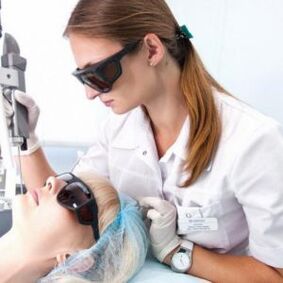
The need for cryodestruction is determined in each case by the attending physician. If a patient has a risk of papilloma degeneration to malignant, removal should be done. Factors influencing the need for cryodestruction are:
- mechanical damage to the neoplasm;
- Decreased level of patient immunity;
- use of oral contraceptives;
- bad patient habits;
- Localization of growth processes in areas that are regularly damaged during life.
Ointments and lotions
You can buy many special lotions and ointments in pharmacies today to get rid of papillomas in the most delicate areas of the skin.
It is necessary to use ointments for cauterization of education only with complex therapy of the virus, which should be carried out with the help of tablet immunomodulators and antiviral drugs.
Multivitamins that improve the state of the immune system and its readiness to produce protective antibodies to the virus will not prevent this.
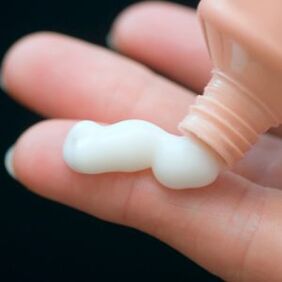
The most available ointment that can defeat papilloma is an ointment containing salicylic acid, which has a keral, bactericidal and restorative effect on the affected tissue. The agent is applied to the affected spot, without affecting healthy surrounding tissues, which can burn along with it.
You can also find ready-made solutions to remove papillomas at any pharmacy. With the help of such solutions it will be necessary to make lotions that will cause the death of pathogenic microflora in the skin area and eliminate papilloma.
Surgical method
Surgical removal of tumors involves the physical removal of papillomas with a scalpel.
Removal surgery is indicated by doctors if the size of the neoplasm exceeds 3 cm in diameter.
When performing the manipulation, the surgeon first disinfects and grows around himself, using disinfectants, then manipulates under local anesthesia and goes directly to excise the neoplasm. After the papilloma is removed it should be sent for histological examination to determine the oncological character in its cells. 2 weeks after surgery, the wound under the removed wart is completely tightened and healed.
The main indications forpapilloma surgery are:
- Large formations, their deep and flat views; the need for immediate elimination of the papilloma;
- Papilloma is a malignant tumor;
- Inadmissibility of other methods of removing education.
Laser removal

The gold standard of modern medicine in the removal of neoplasms is represented by laser removal of papillomas. Until recently, papilloma removal was left behind by scars, but today laser techniques allow you to maintain the beauty of your skin without visible changes.
The basis of laser therapy for papillomas is evaporation, the ability of a beam to cauterize tissue and evaporate life-giving moisture from its surface. The devices allow you to dose the duration and intensity of exposure to skin rays, it depends on the nature of the neoplasm.
Thelaser removal procedure itself goes through several stages:
- First, the doctor conducts a dermatoscopy and determines the type of laser;
- The site of exposure is treated with local anesthetics; The
- laser removal session lasts a few minutes;
- After the procedure, the disinfection site is disinfected and a sterile bandage is applied to it, if contact with clothing is possible in this area;
- The patient provides wound rehabilitation outside the clinic.
After laser removal of papillomas, patients are not allowed to sunbathe, visit swimming pools and spas, take a bath or use any cosmetics on the scar area.
These restrictions are temporary and can be negotiated by a specialist and a patient before leaving the hospital.
Laser removal has many contraindications, both relative and absolute, defined in each case. Most often, this technique is not intended for diabetes, herpes, fever, flu and SARS, diseases of the hematopoietic organs.
Traditional methods
herbs

Since ancient times, using various herbal infusions, healers have eradicated all manifestations of papillomatosis. Many recipes have survived to the present day because they are notable for their effectiveness and negative impact on the body.
A popular folk remedy for HPV is wormwood tincture. With its help you can get rid of formations on the entire surface of the body. The most important thing is to know exactly when and how to get an herbal remedy.
Worm harvesting should be done to some extent. The leaves and flowers are most useful in this herb, but the thick stem is not suitable for tincture. Less commonly, for medical purposes it is recommended to remove the worm root from the ground. All crop parts of the plant are washed and planted on a flat surface. During the drying process the grass should be turned periodically so that it does not dry out. The finished dried grass is stored in a dry glass jar with a tight lid.
Ready-made tincture against worm papillomas not only gets rid of this problem, but also eliminates pathogenic microflora and also has a beneficial effect on the human stomach.
For papillomatosis, the course of tincture is at least 2 weeks, after which there is a break in treatment. Each possible tincture is taken orally 5 drops 6 times a day.
Worm tincture can be prepared in oil, alcohol or brandy. For oil tincture you need 25 grams of worm seeds and 0. 5 cups of olive oil. The seeds are crushed in a coffee grinder and placed in a glass jar burnt in boiling water. The seeds are sprinkled with olive oil on top, everything is mixed and covered with a tight lid. The mixture is placed in a cool place for three days, filtered and ready for use.
Alcohol tincture is made from 100 grams of worm powder, crushed vegetable leaves in a blender and 0. 5 liters of vodka. Everything is stirred for 10-14 days and placed in a glass, then filtered and used according to instructions. The tincture should be stored in the refrigerator.
To make worm tincture on cognac you will need 50 grams of chopped plant root and a glass of cognac. The ingredients are mixed and sent to a water bath for 30 minutes to evaporate. After that, the product is filtered and sent to a dark place for 5 days.
You can also prepare a herbal infusion for the treatment of papillomas, for which horse tail, lemon balm, dandelion roots, plant and nettle are mixed in equal proportions (1 teaspoon each). The mixture is crushed, then 3 tablespoons of the herb is poured into a liter of boiling water and all this is boiled for 10 minutes on low heat. After removing the heat of the infusion, it should be insisted for several hours.
Ready-made tincture is used before meals ¼ for 7 days. The tool strengthens the immune system, which in turn promotes the self-absorption of papillomas.
Soda for healing
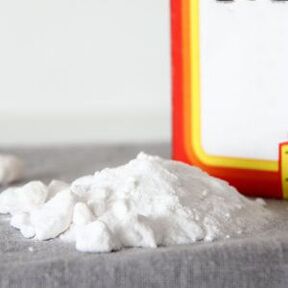
Baking soda has long been used to treat many skin problems, including papillomas. The property of soda is the ability of tutelage in acidic environments, which leads to enhanced immunity, removal of toxins, bacteria and pathogenic microbes create unfavorable conditions. As a result, the viruses in the body stop multiplying and die. The antiseptic and disinfectant effect of soda is also known, which is also useful in treating papillomas. Soda can soften tissues, eliminate the symptoms of the virus and its manifestation - education. For the treatment of HPV, soda is used internally, in the form of inhalations and local lotions.
To prevent the malignancy of tumors and the degeneration of neoplasms in cancerous diseases, some traditional healers suggest drinking a solution of soda in milk. It is made from 1 cup of warm boiled milk and 1 teaspoon of baking soda. The solution is applied three times a day, with each subsequent intake, the mass fraction of soda increases slightly until its concentration in milk reaches 1 tablespoon. However, milk-soda solution is not allowed for those who have pathologies of the gastrointestinal tract.
It is best to consult your doctor before using this recipe.
Inhalation of soda is a more gentle immunostimulation technique. For inhalation, boil 1 liter of water, add 3 teaspoons of baking soda to boiling water, stir, cover the pan, put a towel on top so that the steam does not disappear and breathe in the baking soda vapor until the water cools. Inhalations are held several times a day for 5 days.
Laundry soap
Laundry soap acts on the skin by drying - it removes moisture from them, causing the cells to dry out and gradually die. This feature is very useful in removing papillomas at home. It is the moisture inside the neoplasm cells that promotes its vital activity and if it is stopped, the warts will dry out and disappear.
The most common method of treating papillomas with laundry soap is to use them overnight in the area of the neoplasm. After taking a bath, the area with papilloma is moisturized and washed thoroughly with laundry soap, without damaging the accumulation.
After applying a thick layer of soap you have to wait until it dries and you can lie down. In the morning the soap is washed with plain water, and in the evening the procedure is repeated.
Specifics of treatment in women
Injury of internal and external genitalia

In modern medicine, the treatment of papillomatosis in women is carried out according to different methods, but it is still impossible to completely remove HPV from the body. Therefore, any treatment is aimed at the individual elimination of clinical signs of the disease.
There are many similarities in the treatment of HPV of the female internal and external genitalia. The only difference is that when neoplasms are detected on the external genitalia, specialists can prescribe immunomodulatory drugs in one direction, while on HPV they use stronger drugs on the internal genitals (mucous membranes) that prevent the development of oncopathology.
Treatment of genital papillomatosis in women can be carried out by destructive and therapeutic methods. The required method should be selected by a specialist in each case.
Intraductive papillomas
Because experts classify intraductal papillomas as precancerous conditions of the breast, their treatment is characterized only by the use of surgical methods. In the case of papillary cystadenoma, surgeons perform a sectional resection of the mammary glands, while the tissues are removed through modified canals. Such an operation is performed through a periareolar incision, which allows to maintain the shape and size of the breast in the future without the use of mammoplasty.
If a woman has been diagnosed with intraductal papillary cancer, then a radical mastectomy is used to treat it.
For the prevention of breast cancer, doctors recommend regular mammological examination, early treatment of mastopathy, paying close attention to dyshormonal and inflammatory pathologies in the female genital area.
Treatment for Men
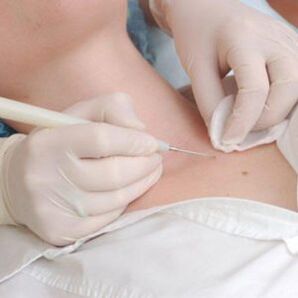
Treatment of HPV with male genital warts is treated with medication and surgery. In this case, drug therapy is aimed at preventing the virus, getting into an anabolic state and strengthening the immune system.
Even small papillomas on the male genitals do not disappear by themselves, so their surgery is common:
- electrocoagulation using electricity;
- Freezing with liquid nitrogen - cryodestruction;
- using a laser;
- Radiosurgery - a non-contact method based on exposure to radio waves of a certain frequency;
- Cauterization with special chemical solutions;
- conventional surgical excision with a scalpel;
- Using ointments that can prevent accumulation.
The method of removing papillomas on the male genitals is selected individually, depending on the characteristics of the course of the infection. All of the above methods of destruction are recognized by doctors as reliable and can be performed without the use of general anesthesia.
What to do if a papilloma is damaged
In case of damage to the surface of the papilloma, the inflammatory process may begin in the affected tissues. Externally, it manifests itself in the formation of the formation of accumulation, swelling, redness, burning and itching. Ichor, mixed with a purulent or serous fluid with an unpleasant odor, starts from the wound. If the state of immunity is satisfactory, soon the tear site dries and deviations are not seen. However, otherwise there is a risk of malignant tumors.
Gross trauma (burns, scratches, scuffs) can cause HPV to spread to nearby tissues and new lesions to grow. Such a process has an even greater predisposition to oncological degeneration.
If the papilloma is damaged, it is necessary to quickly make a sterile swab made of bandage or cotton wool, which was previously soaked in a 3% solution of hydrogen peroxide, and maintain such use for at least 10-15 minutes. After the blood has stopped, the wound is treated with alcohol to disinfect the skin surface, and in the absence of alcohol and fungi in the wound, disinfection is performed using iodine or brilliant herbs, although this will prevent the wound from being monitored in the future.
In case of significant bleeding due to papilloma damage, angioma trauma is diagnosed - proliferation of benign blood vessels. Angioma damage is not dangerous; Oncology does not develop as a result of such pathology.
Where to go in case of illness
If you find different types of skin growths in the first stage, you should consult a dermatologist. This doctor will make the necessary diagnosis, determine the type of virus, and determine the patient's further actions.
Most often, dermatologists think that the sooner a papilloma is removed, the less risk of developing dangerous consequences, but everything is individual. The dermatologist informs the patient about which specialist removal will be needed and which technique is better to choose in this case. The doctor will also prescribe a follow-up regimen, after which it will be possible to consult a surgeon.
If papillomas are found in the genital area, you should seek the advice of a dermatovenerologist. If the formations are localized in the anus, a proctologist will work to treat such pathology. In case of papillomas of the ear-nose-organ organs or oral mucosa, the patient is referred to an otolaryngologist. Genital papillomas in men are treated by a urologist or dermatovenerologist, while in women a gynecologist treats these problems.














































































